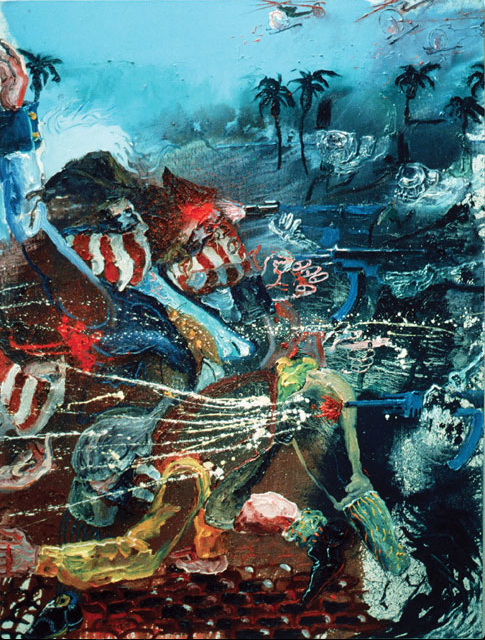Sometimes the success and recognition of an artist isn’t truly revealed until they’ve passed on from this world. Perhaps, Peter Dean, who died in 1993, was ahead of his time during his prolific career. Although his talent was recognized by the art historian and curator, Marcia Tucker, who exhibited his work at the 41st Venice Biennale in 1984; Dean’s potent use of the figure and his commitment to painterly expressionism –while that style of painting was being eschewed– typically kept him at odds with the concurrent trends in art during his career. Because he consciously harnessed the raw energy of gestural action painting in order to question, scrutinize, and divert contemporary life, his subject matter is often tough to digest. However, it is a rewarding experience to be immersed in Dean’s liberated vision. His style is unmistakable and his imagery offers us layers of contextual analysis to keep coming back to.
Dean painted vibrant scenes from American History, which he interpreted using his fantastical imagination. His most iconic imagery portrayed burlesque and grotesque expressions of social and political turmoil; starting with strong reactions to the Vietnam War and continuing to scrutinize the coarse and dehumanizing impact that social injustice has on the collective culture. Through combining history and fantasy, Dean created mythological narratives that invite us to see historical events through new perspectives. His best known works, Dallas Chaos (parts I and II, painted in 1981 and 1982), present several overlapping and conflicting narratives around the assassination of President John F. Kennedy, and question what we think we know as fact and reality. The first painting focuses on the moment when Kennedy was shot. Art and archeology scholar, Ann Merkle, describes the chaotic composition of Dallas Chaos I: “A flurry of policemen, Secret Servicemen, military members, and others swirl around JFK’s central figure, his head drooping towards his lap, splattered with blood. It’s initially a struggle for the viewer to identify who is who amidst the sea of patriotic imagery, with American flags fluttering in the wind and in the hands of onlookers. Individual motives in the painting become increasingly confusing – are the police protecting, or are they threatening the president? The viewer is left to wonder who is good and who is evil, or if there is a distinction to be made at all.”
Merkle also ponders over the similarly anarchic composition of Dallas Chaos II, which depicts the killing of Kennedy’s assassin, reflecting that “Unlike JFK’s assassination, the event presented here is an act of violence that many Americans witnessed in real time on live television. The majority of figures wear disguises, with Oswald in a jester’s motley garment, fierce dogs with the heads of pigs, one policeman in a Klansman hood, and another resembling a Nazi. Members of the media clamor to record the scene with their cameras and video recorders as a gangster-like Jack Ruby swoops in and fires the fatal shot. In response, Oswald contorts, a cascade of masks tumbling down from his face. In this confusing narrative, it is once again nearly impossible to differentiate between heroes and villains.”
This aesthetic and conceptual treatment is all the more relevant in the current era of “Fake News.” Dean was weary about the blind acceptance of things as facts. He understood that events are interpreted and reinterpreted through several lenses, depending on who’s recounting the story and what their motives are. These paintings implore us to question the nature of things more carefully and become more informed about what is going on all around us.

Massacre-Boston-El Salvador, 1983, oil on canvas, 84 x 64 inches






